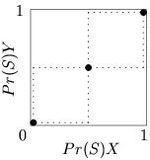An evolutionarily stable strategy (ESS) is a strategy that is impermeable when adopted by a population in adaptation to a specific environment, that is to say it cannot be displaced by an alternative strategy which may be novel or initially rare. Introduced by John Maynard Smith and George R. Price in 1972/3, it is an important concept in behavioural ecology, evolutionary psychology, mathematical game theory and economics, with applications in other fields such as anthropology, philosophy and political science.
In game theory, the Nash equilibrium, named after the mathematician John Nash, is the most common way to define the solution of a non-cooperative game involving two or more players. In a Nash equilibrium, each player is assumed to know the equilibrium strategies of the other players, and no one has anything to gain by changing only one's own strategy. The principle of Nash equilibrium dates back to the time of Cournot, who in 1838 applied it to competing firms choosing outputs.
The game of chicken, also known as the hawk-dove game or snowdrift game, is a model of conflict for two players in game theory. The principle of the game is that while the ideal outcome is for one player to yield, individuals try to avoid it out of pride, not wanting to look like "chickens." Each player taunts the other to increase the risk of shame in yielding. However, when one player yields, the conflict is avoided, and the game essentially ends.
In game theory, the best response is the strategy which produces the most favorable outcome for a player, taking other players' strategies as given. The concept of a best response is central to John Nash's best-known contribution, the Nash equilibrium, the point at which each player in a game has selected the best response to the other players' strategies.
In game theory, the centipede game, first introduced by Robert Rosenthal in 1981, is an extensive form game in which two players take turns choosing either to take a slightly larger share of an increasing pot, or to pass the pot to the other player. The payoffs are arranged so that if one passes the pot to one's opponent and the opponent takes the pot on the next round, one receives slightly less than if one had taken the pot on this round, but after an additional switch the potential payoff will be higher. Therefore, although at each round a player has an incentive to take the pot, it would be better for them to wait. Although the traditional centipede game had a limit of 100 rounds, any game with this structure but a different number of rounds is called a centipede game.
Matching pennies is the name for a simple game used in game theory. It is played between two players, Even and Odd. Each player has a penny and must secretly turn the penny to heads or tails. The players then reveal their choices simultaneously. If the pennies match, then Even keeps both pennies, so wins one from Odd. If the pennies do not match Odd keeps both pennies, so receives one from Even.
In game theory, a player's strategy is any of the options which they choose in a setting where the optimal outcome depends not only on their own actions but on the actions of others. The discipline mainly concerns the action of a player in a game affecting the behavior or actions of other players. Some examples of "games" include chess, bridge, poker, monopoly, diplomacy or battleship. A player's strategy will determine the action which the player will take at any stage of the game. In studying game theory, economists enlist a more rational lens in analyzing decisions rather than the psychological or sociological perspectives taken when analyzing relationships between decisions of two or more parties in different disciplines.
In game theory, the stag hunt, sometimes referred to as the assurance game, trust dilemma or common interest game, describes a conflict between safety and social cooperation. The stag hunt problem originated with philosopher Jean-Jacques Rousseau in his Discourse on Inequality. In the most common account of this dilemma, which is quite different from Rousseau's, two hunters must decide separately, and without the other knowing, whether to hunt a stag or a hare. However, both hunters know the only way to successfully hunt a stag is with the other's help. One hunter can catch a hare alone with less effort and less time, but it is worth far less than a stag and has much less meat. It would be much better for each hunter, acting individually, to give up total autonomy and minimal risk, which brings only the small reward of the hare. Instead, each hunter should separately choose the more ambitious and far more rewarding goal of getting the stag, thereby giving up some autonomy in exchange for the other hunter's cooperation and added might. This situation is often seen as a useful analogy for many kinds of social cooperation, such as international agreements on climate change.
In game theory, the battle of the sexes is a two-player coordination game that also involves elements of conflict. The game was introduced in 1957 by R. Duncan Luce and Howard Raiffa in their classic book, Games and Decisions. Some authors prefer to avoid assigning sexes to the players and instead use Players 1 and 2, and some refer to the game as Bach or Stravinsky, using two concerts as the two events. The game description here follows Luce and Raiffa's original story.
In game theory, strategic dominance occurs when one strategy is better than another strategy for one player, no matter how that player's opponents may play. Many simple games can be solved using dominance. The opposite, intransitivity, occurs in games where one strategy may be better or worse than another strategy for one player, depending on how the player's opponents may play.
In game theory, trembling hand perfect equilibrium is a type of refinement of a Nash equilibrium that was first proposed by Reinhard Selten. A trembling hand perfect equilibrium is an equilibrium that takes the possibility of off-the-equilibrium play into account by assuming that the players, through a "slip of the hand" or tremble, may choose unintended strategies, albeit with negligible probability.
In game theory, a repeated game is an extensive form game that consists of a number of repetitions of some base game. The stage game is usually one of the well-studied 2-person games. Repeated games capture the idea that a player will have to take into account the impact of their current action on the future actions of other players; this impact is sometimes called their reputation. Single stage game or single shot game are names for non-repeated games.
In game theory, a subgame perfect equilibrium is a refinement of a Nash equilibrium used in dynamic games. A strategy profile is a subgame perfect equilibrium if it represents a Nash equilibrium of every subgame of the original game. Informally, this means that at any point in the game, the players' behavior from that point onward should represent a Nash equilibrium of the continuation game, no matter what happened before. Every finite extensive game with perfect recall has a subgame perfect equilibrium. Perfect recall is a term introduced by Harold W. Kuhn in 1953 and "equivalent to the assertion that each player is allowed by the rules of the game to remember everything he knew at previous moves and all of his choices at those moves".
Risk dominance and payoff dominance are two related refinements of the Nash equilibrium (NE) solution concept in game theory, defined by John Harsanyi and Reinhard Selten. A Nash equilibrium is considered payoff dominant if it is Pareto superior to all other Nash equilibria in the game. When faced with a choice among equilibria, all players would agree on the payoff dominant equilibrium since it offers to each player at least as much payoff as the other Nash equilibria. Conversely, a Nash equilibrium is considered risk dominant if it has the largest basin of attraction. This implies that the more uncertainty players have about the actions of the other player(s), the more likely they will choose the strategy corresponding to it.
Equilibrium selection is a concept from game theory which seeks to address reasons for players of a game to select a certain equilibrium over another. The concept is especially relevant in evolutionary game theory, where the different methods of equilibrium selection respond to different ideas of what equilibria will be stable and persistent for one player to play even in the face of deviations of the other players. This is important because there are various equilibrium concepts, and for many particular concepts, such as the Nash equilibrium, many games have multiple equilibria.
In game theory, an epsilon-equilibrium, or near-Nash equilibrium, is a strategy profile that approximately satisfies the condition of Nash equilibrium. In a Nash equilibrium, no player has an incentive to change his behavior. In an approximate Nash equilibrium, this requirement is weakened to allow the possibility that a player may have a small incentive to do something different. This may still be considered an adequate solution concept, assuming for example status quo bias. This solution concept may be preferred to Nash equilibrium due to being easier to compute, or alternatively due to the possibility that in games of more than 2 players, the probabilities involved in an exact Nash equilibrium need not be rational numbers.

In game theory, a simultaneous game or static game is a game where each player chooses their action without knowledge of the actions chosen by other players. Simultaneous games contrast with sequential games, which are played by the players taking turns. In other words, both players normally act at the same time in a simultaneous game. Even if the players do not act at the same time, both players are uninformed of each other's move while making their decisions. Normal form representations are usually used for simultaneous games. Given a continuous game, players will have different information sets if the game is simultaneous than if it is sequential because they have less information to act on at each step in the game. For example, in a two player continuous game that is sequential, the second player can act in response to the action taken by the first player. However, this is not possible in a simultaneous game where both players act at the same time.
In algorithmic game theory, a succinct game or a succinctly representable game is a game which may be represented in a size much smaller than its normal form representation. Without placing constraints on player utilities, describing a game of players, each facing strategies, requires listing utility values. Even trivial algorithms are capable of finding a Nash equilibrium in a time polynomial in the length of such a large input. A succinct game is of polynomial type if in a game represented by a string of length n the number of players, as well as the number of strategies of each player, is bounded by a polynomial in n.
The Berge equilibrium is a game theory solution concept named after the mathematician Claude Berge. It is similar to the standard Nash equilibrium, except that it aims to capture a type of altruism rather than purely non-cooperative play. Whereas a Nash equilibrium is a situation in which each player of a strategic game ensures that they personally will receive the highest payoff given other players' strategies, in a Berge equilibrium every player ensures that all other players will receive the highest payoff possible. Although Berge introduced the intuition for this equilibrium notion in 1957, it was only formally defined by Vladislav Iosifovich Zhukovskii in 1985, and it was not in widespread use until half a century after Berge originally developed it.






